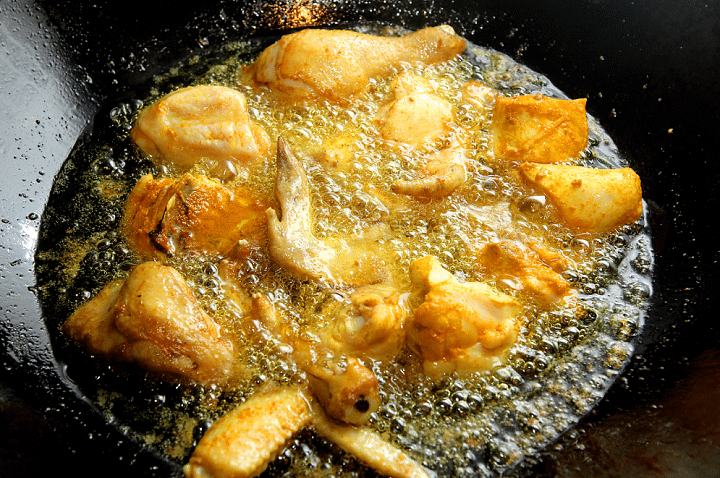You're cooking it in the wrong way.
You're eating it in the wrong way.
History is boiling over with fights and accusations over beloved food and recipes, and how dishes should be prepared.
Whether it's a multi-country dispute over "plagiarised" strawberries, or a storm in a teacup like… Actually, all food fights are very important. They are all taken very personally.
Like Rendangate.
Like when MasterChef UK judge Gregg Wallace tasted contestant Zaleha Kadir Opin's nasi lemak with chicken rendang, and he squawked that the chicken skin was not crispy.
People from several South-east Asian nations took to social media to fry him for saying that, since rendang is usually slow-cooked beef or chicken and is not crispy.
Someone should give rendang a peace prize for uniting Singaporeans, Malaysians, Indonesians and Brunei in brotherly and sisterly defence of a treasured dish.

But just to play the devil's advocate, could there be any kernel of truth to what the food judge said? Perhaps Mr Wallace mistakenly thought nasi lemak had to be served with crispy fried chicken, like what we see in Singapore, and he misspoke?
Here's what Mr Wallace said during the MasterChef UK episode:
"I like the rendang flavour, there's a coconut sweetness, however, the chicken skin isn't crispy. It can't be eaten and all the sauce is on the skin, I can't eat."
Here's what Mr Wallace later said in an appearance on television show Good Morning Britain:
"I said the skin wasn't crispy. I didn't mean it wasn't fried like fried chicken. What I meant was that it wasn't cooked. It simply wasn't cooked."
Nope. He said "rendang". Still banging on about it not being crispy. His skin? Still thick.
Is he trying to goreng his way out of it? Looks like rendang warriors may be right to verbally fry him until his thick skin is crispy.
Are there food fights where accusers got it wrong, though? Read on to find out.
Justice for bao
Xiao long bao warriors waved pitchforks and chopsticks over Time Out London's video which showed dumplings being burst in climactic ways.
There were thousands of comments, many critical of the video. One of them is from Ms Glenda Chua, who wrote: "This was so disturbing to watch my heart stopped every time they burst it this is the opposite of satisfying."
Accusation: The British magazine was scolded for wasting the best part of the soup dumplings, or xiao long bao, by bursting them and letting the broth dribble out before they were eaten.
Apology: Time Out London said sorry and that they had been "politely informed that bursting these lovely little parcels of culinary joy before they reach your lips really isn't the done thing at all". It also shared a link to a Shanghai video showing how xiao long bao should first be nibbled, the soup sipped, then the rest of the dumpling eaten.
Alternatively: While the nibble-and-sip method is satisfying, people who bashed the magazine for letting the soup dribble out before the dumplings were eaten may not be completely right.
According to a printed guide to eating xiao long bao in Taipei restaurant Din Tai Fung, we're supposed to dip the dumpling into sauce, then put it on a spoon and poke a hole in the dumpling to release the broth. Then we drink it up, eat the dumpling, or slurp them in one go.
So bursting xiao long bao (gently, though) before our lips touch it is actually an official way to eat it in Din Tai Fung.
Alternative notes: How about sipping xiao long bao soup with a straw in the United States? Put down your pitchforks. This is a sensible way to slurp the soup in the XL-sized dumpling (or "XL XLBs") sold by US Chinese restaurant Drunken Dumpling. Each one nearly fills a steam basket by itself.

Chopped for 'not being Chinese'
Chop suey, the Chinese-style stir-fried dish of bean sprouts and other vegetables, served in a starch-thickened sauce, is a familiar one in the US, and some Chinese people aren't too hot about it.
Accusation: Chop suey is not Chinese. It's an American creation.
Alternatively: There a number of origin stories, including one in which chop suey is a mispronunciation of "chopped sewage", and a Chinese cook mixed garbage in broth and served it to patrons he's angry with.
However, one story pointed to chop suey being a real Chinese dish.
According to a New Yorker interview with Mr Andrew Coe, who wrote Chop Suey: A Cultural History Of Chinese Food in the United States, it was a local specialty from Taishan, a province town of Guangdong, from where the many Chinese immigrants to the US came from.
Regarding the "chopped sewage" pronunciation, consider how, in Cantonese, tsap seui (za sui in Mandarin) means "scraps". Basically, it is odd-lot vegetables stir-fried together.
Bent out of shape over croissants

Tesco, a large British supermarket chain and a bellwether of sorts for popular tastes, stopped selling the traditional curved pastry a couple years ago, selling instead only straight ones. That spurred dismay on both sides of the English Channel.
75 per cent
Percentage of Tesco customers who prefer straight croissants because of the "spreadability factor". The supermarket said: "The majority of shoppers find it easier to spread jam, or their preferred filling, on a straighter shape with a single sweeping motion."
Accusation: "Croissant" means "crescent" in French. Making it straight isn't right. It's not called "rectiligne".
Alternatively: Straight or diamond-shaped croissants are already commonplace - not least in France, where, traditionally, straight croissants were a superior all-butter product, deliberately differentiated from the cheaper curved, margarine-based version, reported The Guardian.
"A real croissant should be straight. In France when I was working as a baker's apprentice, I learnt the cheap croissant should be curved and the straight ones were always made with butter. So the parents would have a straight croissant and the kids would have a curved croissant." - Mr Richard Bertinet, whose Bertinet bakeries in Bath, Britain, are renowned for their French bread and pastries. He said he sold only straight croissants.
Alternative notes: Buttery croissants, which smell, taste and feel so culturally iconic and French, weren't French to begin with. In as recently as the 19th century, the French viewed the croissant as a foreign novelty, sold only in special Viennese bakeries in the pricier parts of Paris. The pastry originated in what is now Austria, as a crescent-shaped roll called a kipferl.
Sweet and sour strawberries

It seemed such a sweet moment.
A Japanese curler athlete ate Korean strawberries as a mid-game snack and praised them during the 2018 Pyeongchang Winter Olympics.
You might think country-to-country rivalry would melt away over a shared taste in fruit.
But it left a sour taste back home, where there's a lot of national pride in Japan's own varieties. And there's another reason for the bitterness.
Accusation: South Korea plagiarised Japan's strawberry seeds.
"Korean strawberries are based on leaks of Japanese seeds. I'd like our curling team to eat tasty Japanese strawberries." - Mr Ken Saito, Japan's agriculture minister, said at a press conference after the Games, according to a Wall Street Journal report.
$49.5 million
Amount lost every year in export opportunities for Japanese strawberries due to their varieties not being protected in South Korea for years. Japan and South Korea are keen rivals in the export of strawberries to other Asian nations. Most of the main South Korean varieties are the result of cross-breeding of Japanese brands, reported Asahi Shimbun.
Alternatively: The South Korean agriculture ministry pointed to a March 8 press release saying almost all of South Korean strawberries were grown from locally developed seeds. However, up to 2005, a majority of its berries had been based on Japanese seeds.
93 per cent
Amount of South Korean strawberries based on locally developed seeds.
80 per cent
Amount of South Korean strawberries produced up to 2005 that had been based on Japanese seeds.



